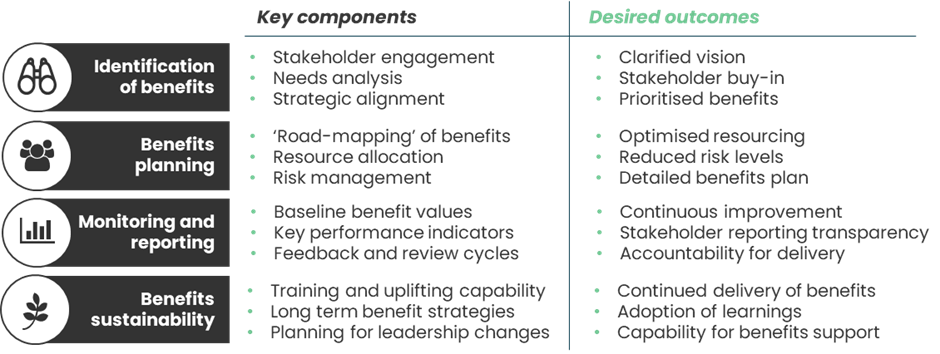
Strategy execution remains one of the most challenging aspects of delivery. To close the gap between planning and action, organisations need to change current practice and enhance ways of working. Achieving this, can be a demanding undertaken and often requires a diverse application of tools and techniques that are outside their business-as-usual activity.
Unless your strategy is “keep doing everything the same”, your organisation will likely require a transformation program to deliver on its desired future state.
The initiatives designed to deliver the objectives of your strategy will likely require a significant level of investment. Understanding how the defined scope will make a measurable progress on the strategy is the role of benefits management, which demonstrate the expected and actual value of any future state investments. Borrowing a term from a famous author – the use of benefits provides a framework to ‘begin with the end in mind’. When done well, benefits management can justify the investment required and to monitor its performance and impact.
The following principles provide visibility on how your organisation is delivering on its strategy and realising benefits.
Align benefits with strategy. Benefits need to demonstrate the progressive achievement of strategic objectives. This may require consideration of multiple levels of benefits over multiple time horizons, to understand the big picture of organisational capabilities and how change to current practice will deliver the required results. Having a clear vision of your organisation’s success, facilitates the ability to plan for its realisation.
Identify measure of success with unambiguous language. What does our end goal mean in clear measurable terms? Are we seeking to increase customer retention or are we looking to grow into a new market segment? The benefits and associated measures need be identified at the outset with the end states in mind. This requires utilising consistent language with clear metrics to ensure alignment with the ability to measure. Understanding what you are planning to measure will also assist with understanding where to source reliable data.
Stakeholder perspectives need to be integrated into program design and delivery. The people within your organisation are the primary mechanism through which change will be delivered. Well-structured and planned stakeholder engagement can help to avoid the common pitfalls of program failure, such as scope creep, cost overruns, quality issues, and stakeholder dissatisfaction. Engagement with leadership and on-the ground staff for benefits will ensure:
Set realistic timelines. Realistic timelines should be established to account for implementation of the full scope of change required to achieve the objectives. It is only once this change has been completed that benefits can commence realisation. Most benefits will be progressive and not be realised immediately. To account for this, achievable targets need to be set, with consideration for overall organisation capacity and capability to handle the expected change.
Write it down in a benefits plan. The plan should outline the activities, resources, responsibilities, calculation methodologies and timelines for delivering the benefits. This needs to include where the data will be sourced from and how it will be reported. Measuring baselines will assist in knowing where the organisation is currently. The plan needs to be a clear roadmap of the scope required to bridge the gap between the current baseline performance and the desired future state as per the strategy.
Governance and reporting at the senior levels. Senior leadership needs to review and evaluate benefits and progress to realisation through formalised governance. This governance ensures that visibility of the overall end state is maintained, with any roadblocks to realisation addressed. Benefits measures should be compared with forecasts with clear actions and ownership for interventions to ensure achievement of the objectives.
The following table summarises the key components of benefits management and outcomes they provide.
